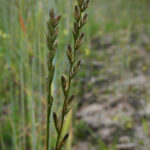Italian Ryegrass
Lolium multiflorum
General Description
Italian ryegrass is a short-lived, highly tillered, cool season biennial bunchgrass. It is usually grown as an annual forage or a quickly establishing, green ground cover. There are two types of ryegrasses: Italian and Westerwold, both with diploid and tetraploid varieties. Ryegrasses cross-pollinate freely and it is difficult to maintain genetic purity. Often, they form a mixture of perennial and annual species.
Type
Tame grass.
Origin
Italian ryegrass originates from northern Italy. Westerwold ryegrass was developed in the Netherlands from Italian ryegrass, and can set seed in the year of sowing.
Longevity
Will only live 1 to 2 years.
Use
Hay, grazing. Italian ryegrass is used for hay and irrigated or intensively managed pasture. It is also used extensively for quick ground cover in post-wildfire rehabilitation and other rehabilitation contexts. Westerwold ryegrass is used for silage, hay, or seed, but winter survival depends on variety, conditions, and management. Italian ryegrass is used as a lure crop for waterfowl and is intercropped with corn in southern British Columbia.
Hay, silage, pasture. It is also used extensively for quick ground cover in post-wildfire rehabilitation and other rehabilitation contexts. Westerwold ryegrass is used for silage, hay, or seed, but winter survival depends on variety, conditions, and management.
Optimal Time of Use
Throughout the season and a good option for extending grazing into late fall and early winter where adapted.
Recovery After Use
Italian ryegrass has excellent tolerance to grazing and quick recovery to use. Allow 3 to 5 weeks for regrowth. Vegetative material is soft and easily damaged by trampling. Although continuous grazing is acceptable, trampling damage can be reduced with managed or rotational grazing.
Italian ryegrass has excellent tolerance to grazing and quick recovery to use. Vegetative material is soft and easily damaged by trampling. Although continuous grazing is acceptable, trampling damage can be reduced with managed or rotational grazing.
Italian ryegrass yielded 8,960 kg/ha (8,000 lb/acre) over 2 harvest operations in 1 year (at Melfort, SK., 1998-2000). Westerwold ryegrass yielded 10,400 kg/ha (9,300 lb/ acre) at the same research site. Single-year yields from three irrigated sites in the Cariboo and Chilcotin ranged from 2,760 to 5,610 kg/ha (2,464 and 5,008 lb/acre). A non-irrigated site in the same region produced 487 kg/ha (435 lb/acre).
Palatability/Nutritional Value
Highly palatable and highly digestible. Fall regrowth showed crude protein 17 to 23% (dependent on sampling time and variety, at Melfort, 1992).
Annual Precipitation min/max (mm)
400mm / 600mm
Drought Tolerance
Low drought tolerance.
Flooding Tolerance
Good tolerance to excess moisture and short periods of flooding.
Winter Hardiness
Low, winter severity determines whether plants survive for a second year.
Soil Texture Preference
Grows best on fertile, well-drained soils but is adapted to a wide range of soil types and textures.
Erosion Control
Can provide quick cover for short-term erosion control, and while perennials are establishing.
Salinity Tolerance
Moderate tolerance.
Acidity Tolerance
High tolerance, will tolerate pH as low as 5.0.
Alkalinity Tolerance
Low tolerance will tolerate pH up to 7.9.
Seeds per kg
501,000 seeds/kg (227,250 seeds/lb)
Suggested Mixtures
Italian ryegrasses can be seeded in mixtures, although it should be seeded at a lower rate to allow establishment of slower to establish perennials.
Ease of Establishment
Italian ryegrasses are easy to establish. Seed in mid- to late May or if concerned about weed pressure, delay seeding until mid- June. Responds well to fertilizer applications (especially N and P). If broadcasting N, apply before seeding or after plant is at the 2- to 3-leaf stage. Functions very well as a nurse crop while establishing other slower growing forage crops.
Competitiveness
Highly competitive in the year of seeding.
Management Considerations
Lack of winter hardiness suggests on planning for use as an annual crop except in areas where winters are typically mild.
BC Rangeland Seeding Manual, USDA Plants Database
Italian ryegrass is adapted to the Sub-Boreal Spruce, Interior Cedar-Hemlock and Sub-Boreal Pine-Spruce zones. In the southern part of the region, it is adapted to wetter parts of the Interior Douglas-fir zone, and to irrigated and subirrigated areas in the Bunchgrass zone and dry parts of the Interior Douglas-fir zone.
Italian ryegrass is adapted to the wetter parts of the Interior Douglas-fir zone and the Interior Cedar-Hemlock zone, and to irrigated and subirrigated areas in the Bunchgrass, Ponderosa Pine zones and drier parts of the Interior Douglas-fir zone.
